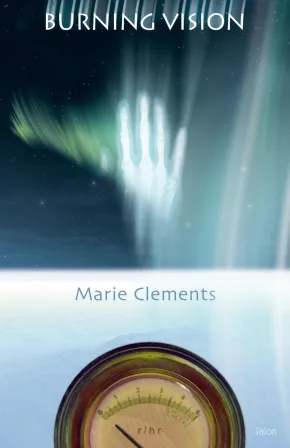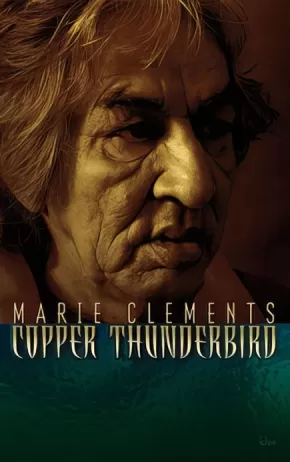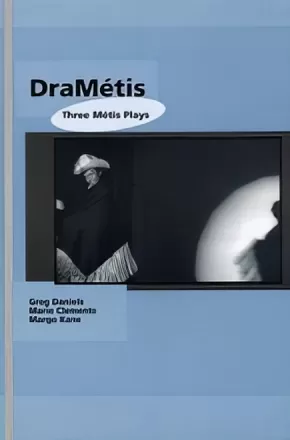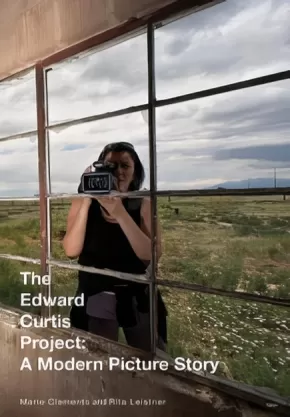Marie Humber Clements
Marie Clements is an award-winning Métis performer, playwright and director whose work has been presented on stages across Canada, the United States and Europe. A fellowship award from the BC Film Commission enabled her to develop the film adaptation of her stage play, The Unnatural and Accidental Women. She is also a regular contributor on CBC Radio. The world premiere of Copper Thunderbird is the first time Canada’s National Arts Centre has produced the work of a First Nations playwright on its main stage.
Books (5)
Synopsis:
Marie Clements’s play sears a dramatic swath through the reactionary identity politics of race, gender and class, using the penetrating yellow-white light, the false sun of uranium and radium, derived from a coal black rock known as pitchblende, as a metaphor for the invisible, malignant evils everywhere poisoning our relationship to the earth and to each other.
Burning Vision unmasks both the great lies of the imperialist power-elite (telling the miners they are digging for a substance to “cure cancer” while secretly using it to build the atomic bombs that devastated Hiroshima and Nagasaki); and the seemingly small rationalizations and accommodations people of all cultures construct to make their personal circumstances yield the greatest benefit to themselves for the least amount of effort or change on their part. It is also a scathing attack on the “public apology” as yet another mask, as a manipulative device, which always seeks to conceal the maintenance and furtherance of the self-interest of its wearer.
Clements’s powerful visual sets and soundscapes contain curtains of flames which at times assume the bodies of a chorus passing its remote judgment, devoid of both pity and fear, on the action: a merciless indictment of the cross-cultural, buried worm of avarice and self-interest hidden within the terrorism of the push to “go with the times,” to accept the iconography of a reality defined, contextualized and illuminated by others.
Marie Clements writes, or, perhaps more accurately, composes, with an urbane, incisive and sophisticated intellect deeply rooted in the particulars of her place, time and history.
Cast of five women and 12 men.
Reviews
“Clements covers a lot of ground, but she knows her territory and travels it deftly… Clements dips her pen in numerous cross-cultural references, from cherry trees to caribou to Hank Williams, and writes with a magical irreverence that highlights this tragic saga. Her rich poetic style evokes parallels between Japanese and native myths – not unlike Yeats’ Noh Plays where Celtic and Japanese myths meld – finding connection through ancient truths and the power of the soil, except in this case the soil is literally explosive.”– Quill & Quire
"I remember reading this play in my undergrad and being shocked and impressed at how much theatre could do and be. This was a far cry from the kitchen sink dramas I had already (naively) decided formed the bulk of contemporary Canadian theatre. Far from the confines of the kitchen, Burning Vision travels across the globe and through time, offering a complex portrait of interconnectedness, shared trauma, and shared responsibility for healing. Fifteen years after it premiered in Vancouver and the subject matter is still, sadly, “of the moment” as we wrestle with climate change and isolationist politics. Requiring a diverse cast to fill parts such as the Dene Seer and Tokyo Rose, and requiring a flexible space so it can be staged in the round, there is no doubt that this play can be challenging. But it is challenging in the best sense of the term, in that it is full of possibilities and invites creative minds in to tackle the important challenges of our day. - Lisa, from PledgeProject
Additional Information
128 pages | 5.50" x 8.50" | Paperback
Synopsis:
Copper Thunderbird is a play on canvases based on the life of Norval Morrisseau. Inside the power-lines which Morrisseau boldly defined in his art were the colours he experienced between his Ojibwa cosmology, his life on the street, and his spiritual and philosophical transformations to become the Father of Contemporary Native Art and a Grand Shaman. Appearing simultaneously in this multi-layered drama as a small boy, a young warrior and an old man, Morrisseau confronts his many selves over the Faustian destiny he encountered during his vision quest—a momentary terror that led to a life wracked by both triumph and ordeal, drawing his vibrant colours, both luminous and dark, from the life-force within him.
Norval Morrisseau is notorious for the life he has led, the company he has kept, the wives, lovers, parasitic drinking buddies and abusive family members he has had and passed through as if they were merely insubstantial phantoms. The paintings he has sold to buy another bottle of alcohol, to get through another brutal day, hang in galleries around the world, a phenomenon Morrisseau himself simply took for granted. Framed variously with the identities of Indian, Artist and Shaman, Copper Thunderbird interrogates both the stereotypes and the politically correct judgments that have manufactured Morrisseau’s public personae, creating a power-figure that transcends culture and morality, earth and water, fire and air.
Additional Information
84 pages | 6.00" x 9.00"
Synopsis:
DraMétis is the first anthology to focus on the emerging discipline of Métis drama. The pieces have all been previously produced and highlight the diversity of Métis drama being written and performed in Canada.
Synopsis:
Peg is struggling for survival at her boarding school. Three über-cool “it” girls take aim at Peg and make her life utterly miserable. When her beloved Grandmother dies she just wants to disappear. Then an unexpected gift arrives; inside it, Peg finds three cast-iron Canadian soldiers. In despair, she throws them against the floor. How can they help her? They are so small, and the girls’ shadow is so big. But, miraculously, the toys come to life as Indigenous snipers from World War I, just in time to wage an epic battle against the girls. A powerful play that will appeal to audiences both young and old, Iron Peggy uses a creative and ever-surprising blend of voices and sceneries to tell this moving story. With 2018 marking the 100th-year anniversary of WWI, Iron Peggy is an excellent introduction to its history and a touching testimony that not only celebrates the First Nation participation in the war effort but also a young girl’s personal victory.
Iron Peggy, by award-winning, international Métis performer and playwright Marie Clements, was commissioned by the Vancouver International Children’s Festival and premiered at Vancouver’s Waterfront Theatre in 2019. (Adapted from Vancouver International Children’s Festival online presentation.)
Educator Information
A powerful play that will appeal to audiences both young and old. With 2018 marking the 100th-year anniversary of WW I, Iron Peggy is an excellent introduction to its history and a touching testimony that not only celebrates the First Nations participation in the war effort but also a young girl’s personal victory. By award-winning, international Métis performer and playwright Marie Clements, commissioned by the Vancouver International Children’s Festival.
Recommended for grades 9 to 12 for Acting, Drama, English Language Arts, and Social Studies.
Additional Information
112 pages | 5.50" x 8.50"
Synopsis:
The two one-act plays in Talker’s Town and The Girl Who Swam Forever are set in a small northern B.C. mill town in the 1960s. They portray identical characters and action from entirely different gender and cultural perspectives. In many ways, the two separate works are inter-related coming-of-age stories, with transformation as a key theme.
The central action in both plays involves an Aboriginal girl, Roberta Bob, who escapes from a residential school and hides out by the river. In Nelson Gray’s Talker’s Town, the story is conveyed by a teenage non-Indigenous boy whose friend has had a relationship with the girl and whose attempts to hush up the affair lead to disastrous consequences.
In Marie Clements’s The Girl Who Swam Forever, the action unfolds from the perspective of the girl, who – to claim her past and secure her future – must undergo a shape-shifting transformation and meet her grandmother’s ancestral spirit in the form of a hundred-year-old sturgeon.
Employing a single setting and working with the same set of characters, the playwrights have created two radically different fictional worlds, one Aboriginal and one non-Aboriginal. Published together, the plays form a fascinating diptych that reveals rifts between Indigenous and colonial/settler histories and provides a vehicle for cultural exchange. As a starting point for trans-cultural dialogue, this set of plays will be of interest to educators, theatre directors, and the general reader interested in the current discourse arising from Canada’s Truth and Reconciliation Commission, Idle No More, and the Indigenous Rights Movement happening throughout North America. Read as a set, these two plays also invite conversations about negotiating creative boundaries, particularly with respect to eco-centric politics and cultural appropriation.
Talker’s Town: cast of 5 men and 1 woman.
The Girl Who Swam Forever: cast of 2 women and 2 men.
Educator Information
Recommended in the Canadian Indigenous Books for Schools 2019-2020 resource list for grades 11 and 12 for Drama and English Language Arts.
Additional Information
160 pages | 5.50" x 8.50"
Teen Books (1)
Synopsis:
A profoundly moving new drama by Marie Clements, combined with a spectacular contemporary photo exhibit by Rita Leistner.
Edward Curtis saw his job as that of creating a photographic record of “the vanishing race of the North American Indian.” His work therefore became as much a projection of colonial attitudes upon aboriginal peoples as it was an authentic record of their lives.
The Edward Curtis Project began when the Presentation House Theatre commissioned Marie Clements to write a play that would stage the issues raised by Curtis’ monumental but controversial achievement—to dramatize not only the creation of his twenty-volume photographic and ethnographic epic and the enormous commitment, unwavering vision, sacrifice, poverty and ultimate disappointment it represented for the photographer, but also the devastating legacy that his often misrepresentative and imposed vision had on the lives of the people he touched.
Upon receiving the commission, Marie Clements immediately asked photojournalist Rita Leistner to create a parallel photographic investigation of Curtis’ work—to question the practice of documentary photography with the very medium under scrutiny. After two years of retracing Curtis’ footsteps, travelling to First Nations communities throughout North America, Clements finally felt that between them: “We were making our own pictures out of our own beliefs and they were adding up. We were inside the lies and beauty of history, of gender and class, we were making a case for the future.”
This collaborative work of two artists, to take Curtis’ photographs to heart and to see who and what might live inside them today, resulted in a profoundly moving new drama by Marie Clements, and a spectacular contemporary photo exhibit by Rita Leistner. Published together here, they illustrate the trauma that the notion of a “vanishing race” has inflicted on an entire people, and celebrate the triumph of a future in which North American First Nations communities “are everywhere and it is beautiful.”












